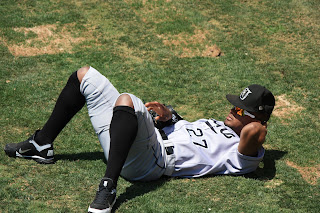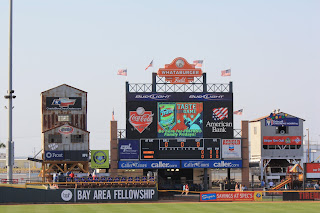Yes, it was a Sunday afternoon in Jackson, Mississippi, the city of my birth and my childhood and the city where my father had been pastor of one of the largest Baptist churches during those years. It was—and still is—a city with such a pious culture that churches and sports leagues and teams often mutually support each other. On this Sunday afternoon, for instance, several church and synagogue groups were identified as attending the game between the Mississippi Braves and the Jacksonville Suns. Meanwhile, the Braves reinforced church attendance by announcing the team's practice that for Mondays’ games fans would be given discounted admission if they brought a church bulletin from the previous day.
 |
| The Sunday congregation at theBraves' Green Cathedral in Mississippi. |
That promotion prompted me to recall a similar bulletin policy established by the church softball league in Jackson. When I had lived there decades ago, attendance at Sunday services was the requirement for players’ participation. While it seemed that my church’s team was always coming in second or third in the league, I wondered whether or not our rival team brought in ringers to play, offering them qualifying bulletins in exchange for potential homeruns. Then the league also had a rule against Sunday afternoon softball practices. Obviously, with Sunday ballgame restrictions no longer effective, choirs and Sunday School groups endorsed the Braves’ Sunday afternoon game as a special outing.
By contrast, the Chick-fil-A concession at the ballpark remained closed on Sunday as an expression of corporate policy. Ever since the food chain's founder and CEO Truett Cathy opened his first restaurant more than sixty years ago, Chick-fil-A's custom has been to respect Sunday as a day for spiritual practice. Adhering to this procedure of remaining closed on Sundays, the company also believes that it expresses how it values its employees by making sure that they have a day to spend in worship, family activities, or personal renewal exercises.
 |
| Chick-fil-A's expression of values. |
For the Braves' game shortly after noon, there was no first pitch, no child selected from the stands to yell, “Play ball,” no Little League team to caddie the home team's starting line-up onto the field. Instead, on this Sunday afternoon students from the secular Japanese Supplemental School in Mississippi sang “Amazing Grace,” even retaining its original phrase: “That saved a wretch like me.” Their rendition contrasts with the popular bowdlerized version in several current church hymnals that preserves some self-esteem by reducing the sting of personal identification as “a wretch” and referring instead to “sinners like me.” The children and a few adult sponsors sang the first verse in English and repeated it in Japanese. Religion still suffuses Mississippi life.
Before the game, I mentioned to Braves’ Assistant General Manager Sean Guillotte that this season the home team had 16-10 record when I had sung. Immediately, he responded, “We’ll have to hire you to sing for us the rest of the season.” The Braves were 15-21 at that point, although they had shut out the Jacksonville Suns the previous night. Without knowing about my record for home team success, Braves manager Rocket Wheeler introduced himself while I lounged by the dugout before game. After I sang, he handed me a ball and said “Thanks. Good job.” That’s the first ball that I have been given on this trip. His evaluation was elaborated by a man wearing an Ole Miss cap and drawling: “You sang it the way it’s s’posed to be sung.”
In the second inning the Braves strung together two singles and a walk, followed by a routine double-play scoring grounder—second to short to first. With a runner then on third, pitcher Brett Oberholtzer singled to drive in a second run. Anything but routine, his hit was the first by a pitcher that I had seen this season. Then tossing seven strong innings, Oberholtzer and two relievers made the runs hold up before adding another for a 3-0 win.
 |
| Reliever Jhan Marinez relishes Sunday afternoon's sunshine. |
During the middle innings of the game I wandered out to a spot overlooking the Suns’ bullpen where relief pitcher Jhan Marinez lay on his back lounging in the warm sun. One of his fellow relievers, Dan Jennings, noticed me also taking photographs of the young members of the grounds crew who were playing soccer nearby.
 |
| The Braves' grounds crew passes time passing a soccer ball. |
Dan called up to me, “Aren’t you the guy who sang the national anthem? Weren’t you at our place a couple of weeks ago?” Yes. I had sung in Jacksonville for the Suns two weeks earlier, on Easter Sunday.
In the conversation that ensued, he asked where I am a professor. When he learned that I teach at Whittier College, he offered, “That’s where I wanted to attend more than anywhere else.” At first, I thought he was pulling my leg; but then he started recounting bits about his visit to campus: “Purple and Gold. Aren’t those the College’s colors? And isn’t it the place that has the rock that students paint?” Yes, again.
During his sophomore year in high school, Dan had toured several California colleges, thinking that he would pursue a baccalaureate degree rather than sign to play professionally. Although Whittier’s team was out of town on the day that he visited campus, he left Coach Rizzo, who is one of my former students, a video of his pitching and a copy of his resume. While he recalled positive impressions about the campus and the baseball program, what had appealed him the most about Whittier was its academic program, especially the faculty masters program that expanded students’ scholarly and cultural opportunities. I enjoyed sharing with him how Bonnie and I had hosted the former Negro League stars to share their experiences during Black History Month on consecutive years when we had directed the programs in Garrett Faculty Masters House.
 |
| The face of the promotional card for my book. |
Dan also inquired about the book that I am writing about the national anthem for the national pastime. His interest was piqued, in part, by difficulties his father—also a professor—had encountered in securing a publisher a few years ago. As we talked about Whittier and my course on sports and religion, which he said he would have taken, I tried to toss him one of the promotional, baseball-style cards for my book Rounding the Bases. Winds swirled, helicoptering the card back up to me on several occasions before I could get it to drop to him below the bullpen wall.
Finally, we talked about where I’d been on the trip and whether the Suns would see me again on the tour. When I described making the trip in Arby with my wife, he responded: “That sounds like a dream come true.”
It is.




































